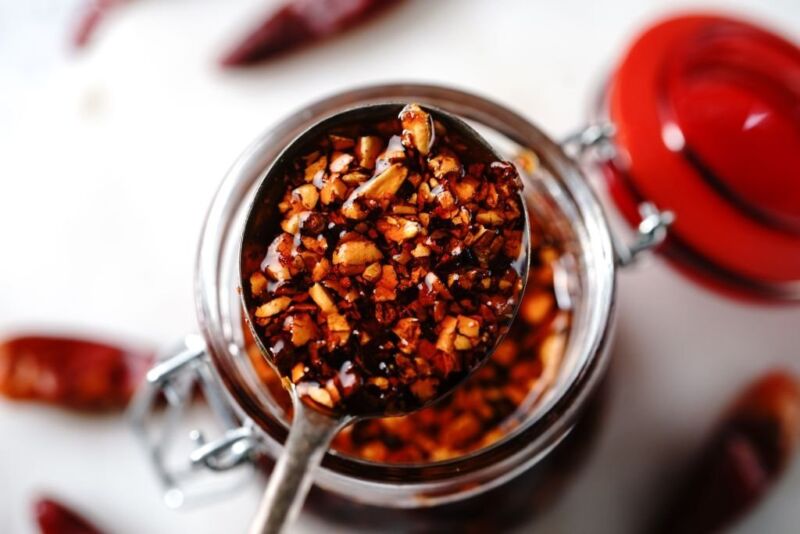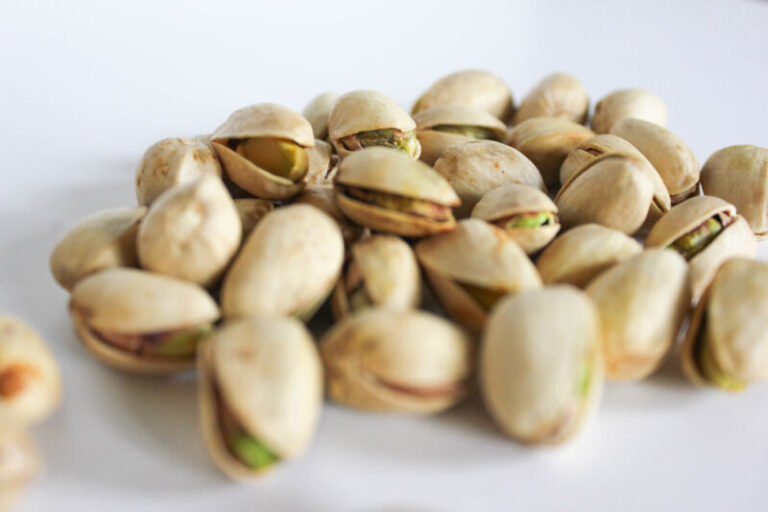Does Chili Oil Go Bad? How to Tell if Your Chili Oil Has Spoiled
Chili oil is one of my favorite condiments to keep in my pantry. Its bold, spicy flavor instantly elevates Asian-inspired dishes, sandwiches, eggs, pasta, and so much more. But like any oil, chili oil does not last forever.
So how long does chili oil last before it goes bad? Unopened chili oil can last up to 1 year past its printed expiration date if properly stored. However, once you open chili oil, its shelf life decreases. When refrigerated in an airtight container after opening, chili oil will maintain peak freshness for 3 to 6 months.
In this article, I will explain everything you need to know about how long chili oil lasts, proper storage methods, signs of spoilage, and uses for chili oil past its prime. Read on to become an expert on chili oil expiration and keeping this spicy pantry staple as fresh as possible!
How Long Does Unopened Chili Oil Last?
Let’s first look at how long chili oil keeps when still sealed in a new bottle.
If stored properly, unopened chili oil lasts:
- 1 year past the printed expiration date
- Up to 2 years from the manufacture date
This shelf life expectancy is for chili oil bought commercially. Homemade chili oil may not last quite as long.
The printed expiration date is the most definitive indicator of how long chili oil stays fresh in an unopened bottle. This date takes into account the harvested date of the chilies and oil plus expected deterioration over time.
You can safely use chili oil for 1 year past its printed expiration date as long as it was stored correctly. However, its pungency and vibrancy slowly fade as the expiration date approaches. The chili oil will still be safe to consume, but older oil may lack the intense hot chili flavors.
If your bottle does not have an expiration date printed on it, see if there is a manufacture or bottling date. You can then estimate the shelf life is around 2 years from that date for chili oil stored properly.
How you store chili oil makes a big difference in how long the unopened bottle will last. Let’s look at the best storage methods next.
How to Store Chili Oil to Maximize Shelf Life
To get the longest possible shelf life from chili oil, follow these storage recommendations:
- Keep chili oil bottles in a cool, dark pantry away from heat sources like the stove or hot water heater. Light and heat degrade the quality of oils.
- Avoid storing chili oil above the stove or oven where temperatures fluctuate. The cooler the storage spot, the better.
- When possible, buy chili oil packaged in dark colored glass or metal containers. This prevents light exposure which speeds up chili oil spoilage. Avoid clear glass bottles.
- Store chili oil away from other light or heat sensitive foods like vinegar, soy sauce, citrus juices, garlic, etc. Keeping like items together helps prolong their freshness.
- Ensure chili oil cap/lid is on tight after each use. Any air exposure starts chili oil’s deterioration countdown.
- Use clean, dry utensils and hands when handling unopened bottles to prevent introducing bacteria or moisture.
By providing cool, dark, dry storage, you can maximize the shelf life of unopened chili oil to the 1 year past expiration date timeline.
Refrigerating Opened Chili Oil: How Long Does it Last?
Once you crack the seal and open your chili oil, its shelf life decreases significantly compared to an unopened bottle. This is due to oxygen, light, and heat exposure that immediately start to degrade the oil’s quality.
Here are general guidelines for how long chili oil lasts once opened:
- Refrigerated: 3 to 6 months
- Pantry: 2 to 3 months
- Countertop: 1 month maximum
For best results, always refrigerate chili oil in an airtight container after opening. The cool temperature helps slow the rate of spoilage.
In the fridge, chili oil keeps well for 3 to 6 months. Start checking its quality after 3 months. If properly stored, it should maintain good flavor and aroma for up to 6 months.
You can also store opened chili oil at room temperature in a pantry. Here it keeps for 2-3 months before quality degradation occurs.
Leaving chili oil out on the counter once opened drastically cuts its shelf life down to just 1 month max. The heat and light cause it go rancid and oxidize rapidly. Always refrigerate chili oil after opening if possible.
To maximize the shelf life of opened chili oil:
- Transfer chili oil to an airtight glass or plastic container. This prevents air exposure which accelerates spoilage.
- Refrigerate immediately after using. Never leave chili oil sitting out.
- Use clean utensils to remove oil. Introducing bacteria, food particles, or moisture speeds up spoilage.
- Limit light exposure by storing in an opaque container.
- Use chili oil within 3-6 months for best flavor. Discard if quality declines before that timeframe.
Signs Chili Oil Has Gone Bad
Chili oil is perishable and will not last indefinitely. Here are the most common signs that indicate your chili oil has spoiled and should be discarded:
- Rancid smell
- Change in color
- Mold growth
- Bubbles or film on surface
I’ll explain each of these signs of spoiled chili oil in more detail below:
Rancid Smell
The most telling sign that chili oil has gone bad is a rancid, unpleasant smell.
Fresh chili oil has a robust aroma of chilies, spices like cinnamon or star anise, and nutty sesame oil. As it starts deteriorating, these vibrant aromas fade.
A rancid, stale, or “off” smell means the oil has oxidized and spoiled. Never taste chili oil if it smells rancid, as consuming rancid oil can cause illness.
Change in Color
When chili oil starts going bad, its vibrant color also fades.
Good quality chili oil is a deep orange-red hue. As it deteriorates, it slowly becomes paler and may turn a muddy brown color.
A dull, muddy appearance signals declining quality and chili oils nearing its expiration.
Mold Growth
Another sign chili oil has spoiled is if you see mold. Check for fuzzy spots, web-like tendrils, powdery film, or greenish-black dots along the sides or bottom of the bottle.
Any mold growth means the chili oil has been contaminated and should be discarded immediately. Do not try to scoop out the mold and salvage the rest. Toss out the entire bottle.
Bubbles or Film on Surface
If you notice bubbles throughout chili oil or white film forming on its surface, this indicates microbial contamination.
Bubbles and film signify bacteria, yeast, or mold has started growing in the oil, causing it to ferment and spoil. Discard chili oil immediately if you see this occurring.
How to Use Chili Oil Past its Prime
I hate to waste food, so if your chili oil is nearing expiration but not completely rancid, you may be able to salvage it:
- Use in stir fry dishes: The bold flavors of stir-fried meats and veggies can mask chili oil that is past its prime.
- Make homemade cleaners: Mix mild rancid oils with vinegar, lemon juice, or baking soda to make all-purpose cleaners. Avoid inhaling fumes.
- Apply to outdoor materials: Wooden patio furniture, grills, or outdoor metal surfaces can be conditioned with chili oil that is slightly “off.” The chili peppers provide protective compounds. Avoid finishes you will directly handle or eat off of.
However, if your chili oil smells very rancid, shows any mold growth, tastes terrible, or looks off in color, it’s best to discard and not consume at all. Chili oil with those traits could make you sick if ingested.
Tips to Make Your Chili Oil Last Longer
Here are my top tips to extend the shelf life of your chili oil:
- Start with high-quality chili flakes and oil. Use dried chili peppers from a trusted source and look for oil with an expiration date furthest in the future.
- Sterilize any equipment before infusing chili oil by washing in very hot, soapy water.
- Only make as much chili oil as you will use within 6 months. Small batches stay fresher compared to large amounts.
- Add a natural preservative like vitamin E oil when making your own chili oil from scratch. This helps prolong its shelf life significantly.
- Store chili oil in opaque, airtight containers away from light and heat. Refrigerate opened chili oil.
- Check for signs of spoilage frequently. Discard at the first hint of rancidity or color changes.
Following proper storage methods and starting with high-quality ingredients gives you the best shot at maximizing how long your chili oil stays fresh, flavorsome, and safe to eat.
The Bottom Line on Chili Oil Expiration
Here is a quick summary of how long chili oil lasts:
- Unopened: Up to 1 year past printed expiration date
- Opened Refrigerated: 3 to 6 months
- Opened Room Temperature: 2 to 3 months
- On Counter Once Opened: 1 month maximum
To keep chili oil as fresh as possible, store bottles in cool, dark places like the pantry before opening. Refrigerate in an airtight container after opening.
Check frequently for signs of spoilage like rancid smells, color changes, bubbles, and mold. Discard chili oil at the first hint of any deterioration.
With proper storage methods, your chili oil can retain its spicy, bold kick for many months past purchase. But remember – does chili oil go bad? Yes! No oil lasts indefinitely. Use your senses to regularly check for any changes indicating chili oil spoilage.
I hope these tips help you reduce food waste and keep chili oil lasting as long as possible. Let me know if you have any other chili oil storage tricks!






